What Is Laser Skin Resurfacing?
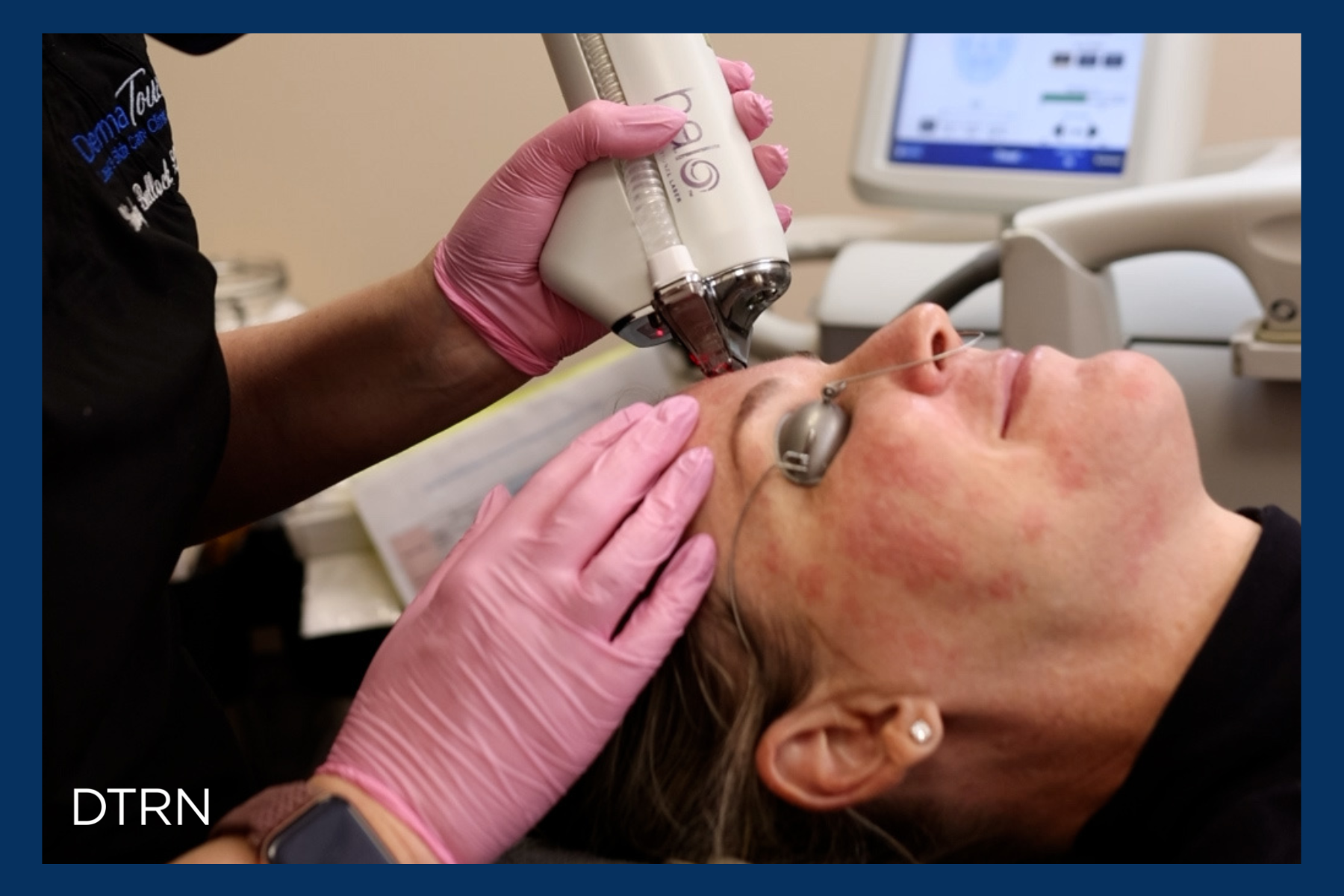
Many people are looking for non-surgical options to help them turn back the hands of time. Laser skin resurfacing is one such option. Read on for answers to common questions about laser resurfacing, including what it is, possible types of laser treatments, and how they work.
Do you have skin concerns like blotchy skin, age spots, fine lines, wrinkles, and scarring? Are you seeking ways to reduce or improve the appearance of these conditions without surgery?
Fortunately, with technological advancements, we have many options, including laser treatments, to improve our external appearance without the need to go under the knife.
To provide us with insights into laser resurfacing, we turn to Houston-based Aesthetician Mindy Goeke.
What is laser skin resurfacing?
Laser skin resurfacing is an aesthetic treatment that treats various skin concerns, including scars, fine lines, wrinkles, hyperpigmentation, blotchiness, rosacea, and more. After a laser resurfacing treatment or series of treatments, the skin looks healthier and more youthful.
According to Goecke, laser resurfacing uses an Erbium or CO2 wavelength to evaporate the skin. It’s performed as either fractionated or full field resurfacing.
“An analogy we use to explain the difference between fractionated and full field is that it’s similar to yard work,” shares Goecke, “Full field is removing a full section of skin, or “mowing the lawn,” whereas fractionated is like “aerating the lawn.” With ablative lasers, we’re completely removing tissue – get out of here, old damaged skin!”
After a laser treatment, collagen production is stimulated, and new skin cells form during the healing process. This leads to skin tightening and a reduction in skin concerns.
What are some popular types of laser treatments?
There are several laser treatment options on the market to choose from. Different lasers use different modes of delivery to generate results. Some lasers treat several similar skin conditions and concerns, while others might only focus on a few concerns.
Here are some of the most popular laser treatment options available today:
HALO
The Halo laser applies hybrid laser technology by combining both ablative and non ablative lasers to stimulate collagen production of the chest, hands, face, neck, and arms. The Halo can help to correct sun damage, uneven skin tone, scarring, discoloration, and enlarged pores.
MOXI
Moxi is a non ablative skin resurfacing laser treatment that stimulates collagen production. It treats the superficial epidermis of the face and addresses early signs of aging, including sun damage and skin discoloration. It also helps to improve skin texture and tone.
BBL (Broadband Light) Therapy
Broadband Light Laser treatment, also referred to as a Broadband Light Photofacial or BBL laser treatment, helps to rejuvenate the skin with the use of intense pulsed light. It can improve the appearance of broken capillaries, hyperpigmentation, skin tone, sun damage, redness, and skin texture.
CoolPeel
“My favorite treatment [here at DermaTouch RN] is our CoolPeel laser,” states Goeke, “It’s a great option because pretty much everyone can benefit from it. Plus, it can be added on to almost any treatment we offer, increasing the overall benefits.”
CoolPeel works to treat a variety of skin concerns, including:
- Signs of premature aging
- Fine lines and wrinkles
- Rosacea
- Enlarged pores
- Benign skin growths (i.e., moles and skin tags)
- Skin texture
- Skin tone
- Acne scarring
- Other scars (like from falling off your bicycle)
The treatment uses an ablative laser that delivers intense infrared light to the outer layers of the skin. It’s used to treat the face, neck, and chest.
Glacial RX
Glacial RX is the first FDA-cleared dark spot treatment. Using a freezing technology referred to as CryoModulation, the treatment temporarily freezes the skin’s melanocytes, leading to a lower production of skin pigment, or melanin, as the skin cells recover and restore.
Sciton ProFractional
The ProFractional laser treatment is an ablative laser used to resurface the skin. The treatment goes deep into the layers of skin, stimulating collagen and helping to reduce the appearance of age spots, scarring, and hyperpigmentation.
See Laser Resurfacing Before & After Photos
Who can benefit from laser skin resurfacing?
Goecke indicates that laser treatments are a great way to address almost every skin concern, including pigmentation, acne scarring, skin texture, enlarged pores, sun damage, age spots, fine lines, and coarse wrinkles. However, there are some individuals that laser skin resurfacing might not be a good option for.
“Darker skin types and certain health conditions may cause an individual to not be a good candidate for ablative lasers,” shares Goecke.
For example, you might not be a good candidate for laser resurfacing if you have a weakened immune system, are pregnant or breastfeeding, have a history of keloid scarring, or have active acne. You also need to be off of certain acne treatments for at least a year before a laser resurfacing treatment.
It’s best to schedule a consultation with an Aesthetician to determine if you’re a viable candidate and which laser treatment options are best for your skin concerns.
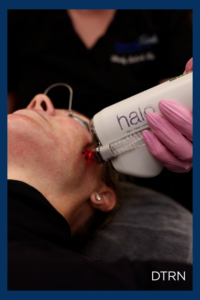
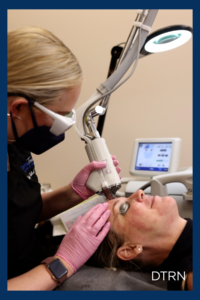
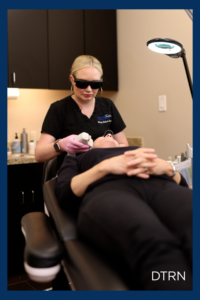
What can you expect following a laser treatment?
The amount of recovery time will depend on the type of laser treatment you receive. In general, some swelling is normal after a laser treatment, as is redness. Some itching and stinging may also occur for up to a few days following treatment.
Eventually, the skin will become dry and peel. For some time following treatment, you’ll need to take special care of the treatment area and avoid wearing makeup until the skin has healed enough to do so. Your Aesthetician or laser provider should provide you with pre and post care instructions.
When’s the best time of year to get a laser treatment?
Because you must be out of the sun for a period of time leading up to and following a laser treatment, it’s best to schedule your laser skin resurfacing for the fall or winter time frame. You definitely don’t want to schedule a treatment when you know you’ll be out in the sun a lot or leading up to your beach vacation.
How much does a laser resurfacing treatment cost?
The cost of a laser resurfacing treatment can vary greatly based on the:
- Type of laser used
- Provider
- Treatment area
- Location of provider
At DermaTouch RN, the cost of a laser treatment can range from a few hundred to a couple of thousand dollars.
Schedule a laser skin resurfacing consultation
If you’re curious or wondering if a laser skin resurfacing treatment is right for you, contact your local MedSpa or laser treatment Provider to schedule a consultation. You can schedule with one of the experts at DermaTouch RN online 24/7!
Mindy Goecke, Aesthetician
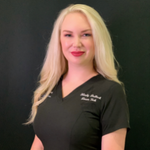
Mindy is a Houston-based Aesthetician with over a decade of experience helping patients utilize the best skin care products and treatments to meet their skin care goals and needs. She is continually striving to provide the best care to her patients and educate them on skin care and treatments, while constantly learning, seeking, and applying the best state-of-the-art treatments and latest trends, so she can apply what she learns to support clients in achieving their desired results for the short- and long-term. Learn more about Mindy and the team of professionals she works with.
DermaTouch RN offers minimally invasive and non-invasive treatments for men and women in Houston, San Antonio, Spring and Cypress, as well as the surrounding areas of Texas. We are the largest aesthetic practice in the Houston area, and all of our medical spa treatments are performed by a team of nurse practitioners, registered nurses, and aestheticians who receive continuing education to remain abreast of emerging treatments that benefit our patients. We invite you to learn more about our office before your consultation.




